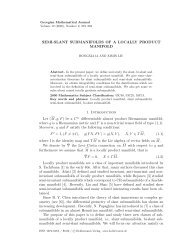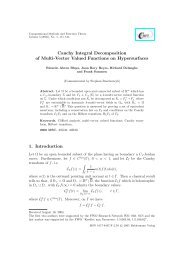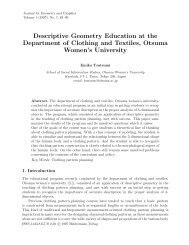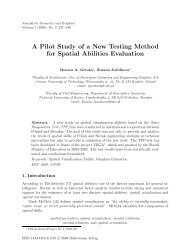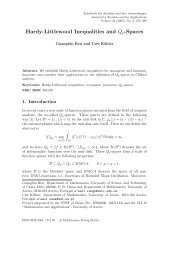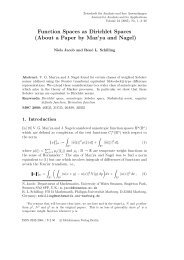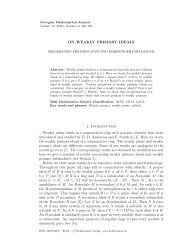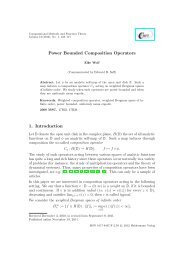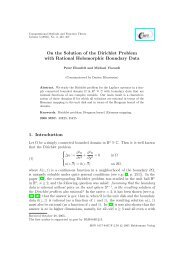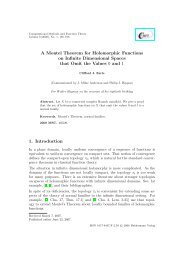Schwarz-Christoffel Formula for Multiply Connected Domains
Schwarz-Christoffel Formula for Multiply Connected Domains
Schwarz-Christoffel Formula for Multiply Connected Domains
Create successful ePaper yourself
Turn your PDF publications into a flip-book with our unique Google optimized e-Paper software.
12 (2012), No. 2 <strong>Schwarz</strong>-<strong>Christoffel</strong> <strong>Formula</strong> <strong>for</strong> <strong>Multiply</strong> <strong>Connected</strong> <strong>Domains</strong> 461<br />
from (33) where the last inversion of γ e ∈ E is z(m) ∗ , i.e. γ e(z) can be written as<br />
γ e (z) = z(k ∗ pk p−1···k 1 m)<br />
with odd p. The relation (11) implies that<br />
(37) µ(z) = z − γ t((z lk ) ∗ (m) )<br />
w − γ t ((z lk ) ∗ (m) ) w − γ t (a m )<br />
z − γ t (a m ) ,<br />
where γ t (z) = z(k ∗ 1 k belongs to 2···k p) O′ m. One can see that (37) gives the required<br />
first asymptotic (36) <strong>for</strong> F (z; ξ 1 , ξ 2 , . . . , ξ n ). It follows from (37) and (3) that the<br />
multiplier from (33)<br />
∏M m<br />
[µ(z)] β lm/2<br />
contains the multiplier<br />
l=1<br />
∏M m<br />
[z − γ t (a m )] −βlm/2 = [z − γ t (a m )] −1 .<br />
l=1<br />
Similar arguments can be applied to obtain the required first asymptotic (35) <strong>for</strong><br />
F (z; ξ 1 , ξ 2 , . . . , ξ n ) by use of<br />
ν(z) = z lk − γ o (z)<br />
z lk − γ o (w)<br />
where γ o ∈ O. One can see also that the multiplier from (33)<br />
∏M m<br />
[ν(z)] β lm/2<br />
l=1<br />
contains [z − γ s (a m )] −1 <strong>for</strong> some γ s ∈ E ′ m.<br />
There<strong>for</strong>e, the function F (z; ξ 1 , ξ 2 , . . . , ξ n ) contains the multiplier<br />
<strong>for</strong> γ s ∈ E ′ m (the multiplier<br />
[z − γ s (a m )] −2+iξm<br />
[z − γ t (a m )] −2+iξm<br />
<strong>for</strong> γ t ∈ O ′ m) which determines its behavior near the singular point z = γ s (a m )<br />
(z = γ t (a m )). One can see that F (z; ξ 1 , ξ 2 , . . . , ξ n ) has the same behavior as<br />
exp(ω(z)) at these points if and only if ξ m = 0.<br />
The theorem is proved.<br />
Remark 1. It follows from Theorem 4 that<br />
S(z) = O(|z| −3 )<br />
(see (3) and (15)–(16)) that corresponds to [8].<br />
as z → ∞



